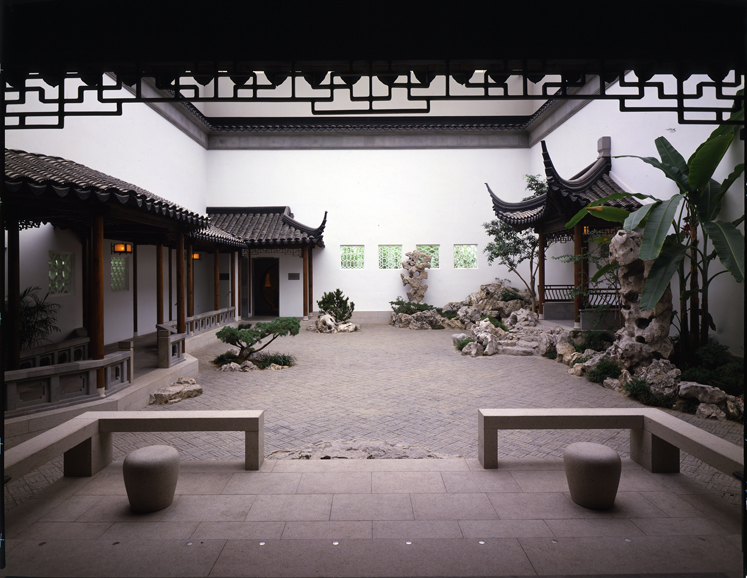“In this image,
there lies deep meaning. Yet when we would express it, the words suddenly fail us.”
…Tang Dynasty (618-906), poet Tao Ch’ien
Among the most renowned gardens in China are the six Classical Gardens of Suzhou, (The Venice of the East). During the Ming Dynasty (1368-1644), Suzhou experienced a flourishing garden culture. The traditional whitewashed houses of that period, crowned by black tile roofs with decorated corner eaves sweeping to the heavens, still line the banks of a network of canals winding under moon bridges. The gardens, enclosed in secluded courtyards, have enticing names designed to conjure poetic and historical associations, such as Humble Administrator’s Garden, A Garden to Linger in, Mountain Villa With Embracing Beauty, Couples Retreat Garden, Garden of Civilization and the Garden of the Master of Fishing Nets.
However, New Yorkers need not journey all the way to China to experience these enchanting pleasures, because a Ming Dynasty-style garden, featuring the mysterious Taihu rocks, is in The Metropolitan Museum of Art.
In 1981, the late Tarrytown resident Brooke Astor conceived and funded the recreation of the Garden of the Master of Fishing Nets at The Met, using natural and manmade materials from China that were assembled with traditional tools. Like me, Astor spent her childhood in China, where she grew to love the courtyards so essential to traditional Chinese architecture and gardens. Remembering the serenity of these enclosures away from the busy city streets, she thought such a space in The Met would provide a quiet area where visitors could rest and reflect upon the landscape paintings in the adjoining galleries. There ancient scrolls echo themes of gardens and the contemplative life. Brooke felt her Chinese Garden would help visitors bridge the cultural gap between the more familiar garden arts of the West and the lesser-known ones of the Far East.
Perhaps the most remarkable difference between Western and Chinese gardens is the use of space weirdly shaped Taihu rocks to create a serene setting designed to capture an eternal moment of suspended time when man and nature seem to be in perfect accord. The ideal Chinese Scholars Garden is fashioned to give almost perfect expression to the Taoist-inspired sense of unity with nature. It was this inexpressible experience of the Tao that the architects of ancient gardens strove to make possible within the confines of their garden walls. The natural landscape around a pavilion became a jardin trouvé, which in its turn was seen as a microcosm of the universe.
The Astor Chinese Garden Court is accented by three types of spectacular Taiho rocks representing imaginary mountains. They are prized by rock connoisseurs for their grotesque shapes punctured by Swiss cheese holes, signifying eyes. Taihu rocks are not works of nature alone. Since the Song Dynasty (960-1279), masons have quarried these carbonated limestone boulders from the mountains near Suzhou and lowered them into Lake Tai where they are left to corrode for decades before “harvesting.”
Through epochs of erosion caused by the action of dense mineral waters and sand, the rocks acquire worn surfaces and crevices. If the harvester is not satisfied with the rock’s natural formation, he may improve on nature’s handiwork by enlarging the crevices and returning the rock to Lake Tai for further erosion. This type of enhanced Taihu may be harvested three generations later by the mason’s grandson and is appropriately called “Grandfather’s Rock.” A Taihu rock should be wide at the top and tapering toward the bottom, so it looks dangerous even thought there’s really no risk. They must have three traditional criteria, giving the illusion of a great peak — tou, which suggest that they could be scaled; lou or the “eyes” that give them a ringing sound like jade pendants; and sou, or leanness, which means “rising like a wall against the sky, lonely and unsupported.”
Taihu rocks have been used for centuries to make artificial miniature hills in royal courtyard gardens. The best-known rock hill, named Duixiu (Heaped Elegance), is in the Imperial Palace Garden of Beijing’s Forbidden City.
But thanks to Brooke, we have our own place of Tao bliss amid the hustle of Manhattan.
For more, visit metmuseum.org.





